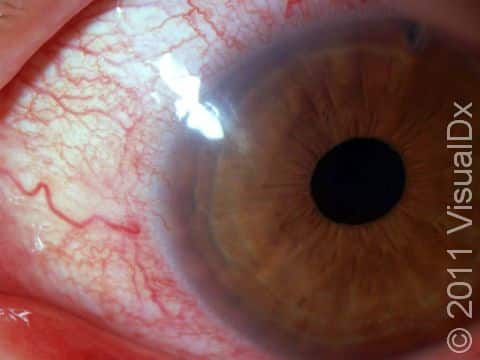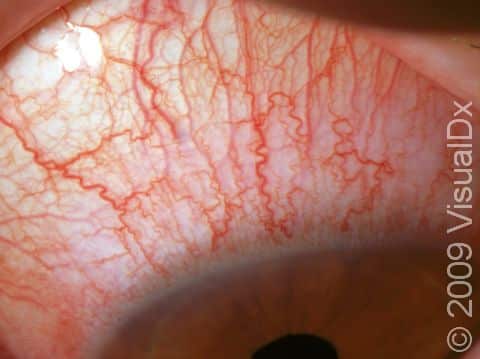Contact Lens Solution Toxicity
Contact lens solution toxicity refers to an unwanted reaction in the eyes caused by the use of contact lens solutions. There may be a reaction to the active ingredient in the solution, the vehicle (what the active ingredients are dissolved in), or a preservative in the solution. The reaction may be noninfectious (inflammatory), allergic, or both.
There are many different types of solutions used with contact lenses, and any can cause a toxic reaction, such as:
- Cleaning solutions.
- Rinsing solutions.
- Disinfecting solutions.
- Multipurpose solutions.
- Rewetting solutions.
- Artificial tear products.
Who's At Risk?
A large percentage of contact lens wearers experience a reaction to a contact lens solution at some time. Most often, this occurs when there has been a switch to a new solution. But even after years of using the same product, the manufacturer may change the formula, which may then cause an issue. Contact lens wearers who overwear their contact lenses or who do not properly clean their contact lenses are at higher risk of contact lens solution toxicity. Contact lens wearers who are having problems with the fit and the comfort of their contact lenses are also at greater risk. Additionally, any other condition that might cause redness and irritation of the eyes will also make contact lens wearers more susceptible to contact lens solution toxicity.
Signs & Symptoms
Although you may not be able to see any distinct changes in the eye, there are certain clues to suggest contact lens solution toxicity. One clue is that the symptoms only seem to occur when you use a particular solution. Take note if the issue occurs following use of a previously used product, particularly if it has a label that says “new and improved.” Individuals with contact lens solution toxicity can experience:
- Redness of the eyes.
- Pain.
- Itching.
- Tearing.
- Sensitivity to light.
- Decreased or blurred vision.
- Discharge from the eyes.
- Inability to wear their contact lenses.
Self-Care Guidelines
If you suspect you may be having a reaction to your contact lens solution, stop using the product immediately and remove your contact lenses. You may also:
- Apply cold compresses to help relieve itching and swelling.
- Apply warm compresses to help relieve aching, pain, or discharge.
- Rinse the eyes very gently with cool water.
- Avoid rubbing the eyes, as this will make the reaction worse.
Once the eyes appear and feel fully normal, then you can try other brands or formulations of contact lens solutions. Also be sure to thoroughly clean your contacts and avoid overuse (eg, wearing them overnight).
Always check expiration dates on your contact lens solutions, and never use expired products. Always handle your solutions carefully to avoid contaminating the tip of the bottle. If the tip gets contaminated with bacteria, it can lead to blinding complications. Finally, always make sure that the solutions you are using are compatible with your type of contact lenses.
Treatments
The eye care professional can help determine if the issue is due to ill-fitting contact lenses or a particular contact lens solution. You may be prescribed eye drops and/or ointments, depending on how severe the reaction is and what other issues may be associated with your contact lens solution toxicity.
Visit Urgency
If self-care measures and changing your contact lens solution do not solve the problem, see an eye care professional. They can ensure your contact lenses fit correctly and guide you in lens solution choices. Additionally, the eye care professional will check for any underlying disease of the eye.
The following situations require immediate medical attention:
- Progressive vision loss
- Progressive pain
- Thick or pus-like discharge
- No improvement or worsening of your eye condition after 24 hours without the use of contact lenses or exposure to contact lens solutions
Trusted Links
References
Boyd K. How to take care of contact lenses. American Academy of Ophthalmology. https://www.aao.org/eye-health/glasses-contacts/contact-lens-care. 2022 Apr 22.
Stuart A. Contact lenses: when a solution is the problem. American Academy of Ophthalmology. https://www.aao.org/eyenet/article/contact-lenses-when-solution-is-problem. 2012 Aug.
Last modified on January 29th, 2024 at 9:11 am

Not sure what to look for?
Try our new Rash and Skin Condition Finder

